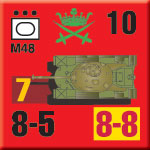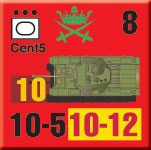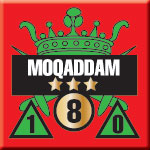| Voice of the Arabs:
Scenario Preview, Chapter Two
By Mike Bennighof, Ph.D.
July 2023
 Graduate school is a traumatic experience. It’s designed that way, and is usually made worse by the deep emotional need of many tenured faculty to humiliate and degrade those below them, with graduate students near the very bottom of the pecking order (adjuncts being at the very bottom). Graduate school is a traumatic experience. It’s designed that way, and is usually made worse by the deep emotional need of many tenured faculty to humiliate and degrade those below them, with graduate students near the very bottom of the pecking order (adjuncts being at the very bottom).
This is why I love crafting alternative histories, that hew closely to the actual events, people or technology, but then take a sharp left turn. Most of the stuff, I don’t actually make up – the ships and airplanes of the Second Great War, for example, usually existed as drawing-board studies. My fellow grad students and I, when drinking heavily, would fantasize about slipping whacked-out “alternative facts” into lectures, knowing that the sheep-like undergrads would dutifully note them down and regurgitate them when asked.
I never did that for real – the risk of some little snot recording your insistence that Marie Antoinette invented the stripper pole was just too great – and I don’t know that anyone else did. But I thought about it. A lot. And so every alternative-history piece I craft these days is an upraised middle finger to the history faculty back at old F.U.
1967: Voice of the Arabs isn’t exactly an alternative history: it’s a small scenario book for 1967: Sword of Israel based on the lunatic ravings of Ahmed al-Said of Radio Cairo’s Voice of the Arabs channel. He was a precursor to latter-day political hate radio, spewing lurid fantasies and calling them truth. And like his broadcasting descendants, he didn’t believe his own crap, either. But it does make for a very different wargame experience.
Let’s have a look, then, at the second and final chapter of Voice of the Arabs:
Eastern Front
4 June 1967
Immediately after the unprovoked air attacks on Egypt, the Royal Jordanian Army and Air Force struck against the Israelis in solidarity with their Arab brothers. Activating long-prepared plans, Jordanian brigades moved to cut off West Jerusalem from the rest of Israel and isolate the division-sized Israeli 16th Jerusalem Infantry Brigade there. With the Israeli garrison pocketed, next the Jordanians would drive the 14.5 kilometers (less than 10 miles) from their forward positions in the West Bank to the Mediterranean beaches.
None of that happened; the Jordanians fell for Egyptian lies about the outcome of the Israeli air strikes and joined the war, only to meet their own defeats and the loss of the West Bank. But once again, that’s not how the Voice of the Arabs told the story, surprising even the Jordanian general staff who had piped the program into their headquarters.
Scenario Seven
Operation Tariq
June 1967
 North of the narrow corridor connecting Jerusalem to the rest of Israel, the Royal Jordanian 40th Armored Brigade had the task of breaking through the Israeli cordon to link up with Jordanians advancing from the south. The Israelis held the corridor with a second-line outfit, having placed their main effort on the Sinai front. With the Egyptian victories there, their Central Front faced extreme challenges. North of the narrow corridor connecting Jerusalem to the rest of Israel, the Royal Jordanian 40th Armored Brigade had the task of breaking through the Israeli cordon to link up with Jordanians advancing from the south. The Israelis held the corridor with a second-line outfit, having placed their main effort on the Sinai front. With the Egyptian victories there, their Central Front faced extreme challenges.
Conclusion
With most Israeli armor facing the Egyptians, and control of the air in the hands of the Arab air forces, the Israeli reservists could not hold back the Jordanian armor. The Jordanian tanks rent the Israeli brigade in two, and rumbled on to join up with the 27th “Imam Ali” Infantry Brigade. In the actual Six-Day War, the Israeli Air Force was fully intact rather than destroyed, and kept the Jordanian armor from even beginning this attack.
Notes
It’s a Jordanian tank attack against an Israeli infantry defense, and unlike most such operations in 1967, the Israelis don’t have much in the way of armor support of their own. Infantry is pretty potent against tanks in Panzer Grenadier (Modern) – this is not 1941 – but the IDF lacks the longer-range anti-tank capability of other armies of the era.
Scenario Eight
Negev Tank Battle
June 1967
 Before the Royal Jordanian 60th Armored Brigade could deploy against the Israelis around Jerusalem, the Araba supreme commander, Egyptian Field Marshal Abdul Hakim Amer, ordered it to advance on Beersheba. There it would link up with an Egyptian division advancing from Sinai. The Jordanians rolled southward and into Israeli territory, only to find the Israelis prepared for their move. Before the Royal Jordanian 60th Armored Brigade could deploy against the Israelis around Jerusalem, the Araba supreme commander, Egyptian Field Marshal Abdul Hakim Amer, ordered it to advance on Beersheba. There it would link up with an Egyptian division advancing from Sinai. The Jordanians rolled southward and into Israeli territory, only to find the Israelis prepared for their move.
Conclusion
The Israeli and Jordanian armor collided in the desert east of Beersheba, where the elite Israeli brigade gave way to the Jordanians after bitter fighting. That’s the Voice’s version; in the universe of reality, Israeli airstrikes kept the Jordanian brigade from even reaching the “Green Line” dividing the West Bank from Israel.
Notes
It’s a meeting engagement between Jordanian and Israeli M48 Pattons, with the Jordanians of this warped reality able to match IDF standards of training and coordination. That could only happen in the delusional world of Ahmed al-Said; the Arab countries in 1967 simply did not have the broad-based educational system to turn out tens of thousands of potential junior officers and technical specialists.
Scenario Nine
Pillar of Fire
June 1967
 The Egyptian “Sword of the Sinai,” the 4th Armored Division, sliced through Israeli attempts to stop its inexorable advance. The well-coordinated Arab high command brought Jordanian armor and infantry to mee them. That left the Israeli 31st “Pillar of Fire” Armored Division caught between hammer and anvil. The Egyptian “Sword of the Sinai,” the 4th Armored Division, sliced through Israeli attempts to stop its inexorable advance. The well-coordinated Arab high command brought Jordanian armor and infantry to mee them. That left the Israeli 31st “Pillar of Fire” Armored Division caught between hammer and anvil.
Conclusion
Caught between the Egyptians and Jordanians, the Israelis forced them apart for some hours but without air support they could not prevent their eventual junction. Israel had been cut in half, with more defeats to come. The Voice of the Arabs exulted. In the actual Six-Day War, the Voice did exult; nothing else about this scenario is true, though.
Notes
When the chance presents itself, I like to include a giant-sized scenario suitable for team play. The Voice gave no details about this massive clash of armor, leaving me to make them up, so I crafted a scenario that can be played by two, three or four players or teams. The two Israeli brigades are sandwiched between the oncoming Egyptians and Jordanians, and have to keep them apart.
Scenario Ten
Beaches of Netanya
June 1967
 The seaside town of Netanya lay less than ten miles from the Jordanian border. That made it the objective of the Royal Jordanian Army’s 1st “Princess Alia” Infantry Brigade, one of the kingdom’s tough Bedouin outfits facing a brigade of Israeli reservists. A breakthrough would sever Israeli communications between north and south, and carry heavy symbolism to both sides. The seaside town of Netanya lay less than ten miles from the Jordanian border. That made it the objective of the Royal Jordanian Army’s 1st “Princess Alia” Infantry Brigade, one of the kingdom’s tough Bedouin outfits facing a brigade of Israeli reservists. A breakthrough would sever Israeli communications between north and south, and carry heavy symbolism to both sides.
Conclusion
Backed by their own Centurions, the Jordanian infantry fought their way through a determined Israeli defense to touch the Mediterranean. The Voice had another victory to proclaim to the Arab world, once again manufactured from whole cloth. In the actual Six-Day War, the Princess Aliya Brigade was the one thrown onto the defensive (which it carried out successfully until its flanks were unhinged).
Notes
This is an infantry fight, with the Jordanians wielding a small amount of tank support (you finally get to use those Jordanian Centurions). The Jordanians are pretty good; the Princess Aliya Brigade really did fight well in 1967, not least because it had been assigned plenty of artillery including 155mm American-made “Long Tom” cannon (since they could hit Tel Aviv from these positions).
Scenario Eleven
Gates of Tel Aviv
June 1967
 The Israeli capital would be the final objective of the Arab offensive, where the Israelis could be expected to make their final stand. The Israeli GHQ reserve dug in outside the thriving city, while the Jordanians prepared their assault and the Egyptians raced to take part. Arab air superiority made it difficult for the Israelis to move their formations except at night, while the conquest of Netanya and Beersheba had isolated the capital already. The Israeli capital would be the final objective of the Arab offensive, where the Israelis could be expected to make their final stand. The Israeli GHQ reserve dug in outside the thriving city, while the Jordanians prepared their assault and the Egyptians raced to take part. Arab air superiority made it difficult for the Israelis to move their formations except at night, while the conquest of Netanya and Beersheba had isolated the capital already.
Conclusion
The Israelis fought for every stone and every brick, slowing the Jordanian advance even after the Egyptians arrived on the scene. But the Arab allies ground forward, until a UN ceasefire – backed by both the United States and the Soviet Union - took effect and brought the fighting to an immediate halt. Israel would survive, but the Middle East would never be the same.
Real events caught up with the Voice at this point, with the Arabs pounding on the gates of Tel Aviv. The fractured fantasy tale of conquest abruptly gave way to drama over President Nasser’s resignation and “reluctant” return.
Notes
It’s an Arab mechanized assault, with the Jordanians starting things off and Egyptian reinforcements joining them, with all the coordination problems you might expect. The Israelis are, as always, pretty tough and the GHQ reserve (10th Mechanized Brigade) is a front-line outfit though its tank strength is filled out with AMX-13 light tanks alongside the Centurions and up-gunned Shermans.
And that’s all for Voice of the Arabs.
You can order Voice of the Arabs right here.
Arab-Israeli Package
1967: Sword of Israel (Playbook)
IDF: Israel Defense Forces
Voice of the Arabs
Retail Price: $147.97
Package Price: $120
Gold Club Price: $96
You can experience the Arab-Israeli Package right here.
Sign up for our newsletter right here. Your info will never be sold or transferred; we'll just use it to update you on new games and new offers.
Mike Bennighof is president of Avalanche Press and holds a doctorate in history from Emory University. A Fulbright Scholar and NASA Journalist in Space finalist, he has published an unknowable number of books, games and articles on historical subjects.
He lives in Birmingham, Alabama with his wife, three children and his new puppy. He will never forget his dog, Leopold.
Want to keep Daily Content free of third-party ads? You can send us some love (and cash) through this link right here.
.
|
